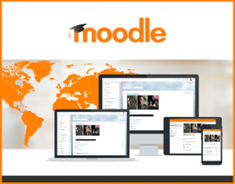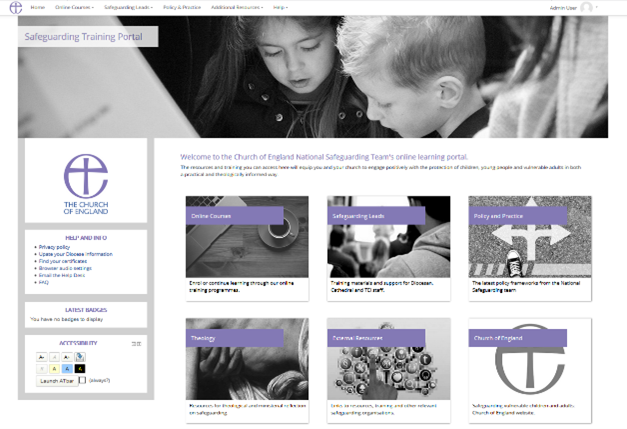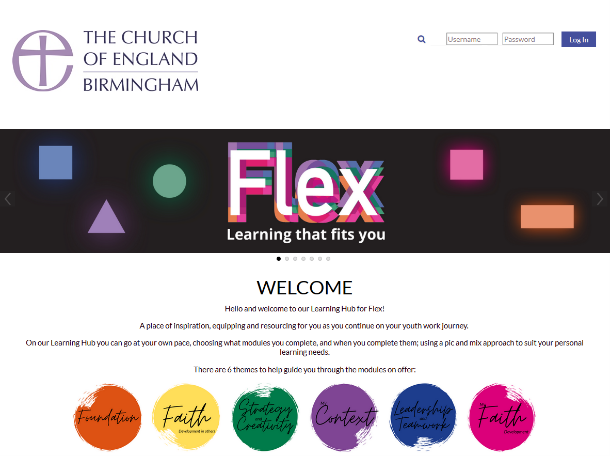What is a VLE and why use Moodle?
What is a VLE?A Virtual Learning Environment offers a suite of resources that support learning in a shared, controlled, web-best platform. A VLE can be implemented and used in different ways in different circumstances using those aspects of the VLE that are appropriate to the task. In Higher Education a VLE is used for communication, disseminating information and promoting deeper learning. |
|---|
 Thus
a student might use a VLE to check for news items from the lecturer, check key
information about their course of study, download reading for forthcoming
lectures, check through the PowerPoint from their last lecture, engage in a
reflective discussion in a forum, watch a short video, access online journals,
submit their essays, see their feedback and marks. Tutors can use tools to
create learning pathways within their course. A VLE can of course be used to
deliver all of the teaching on a course, but in ministerial training this is
normally “blended” with face to face teaching. Research suggests that a blended
approach offers better results than purely online or face to face. Thus
a student might use a VLE to check for news items from the lecturer, check key
information about their course of study, download reading for forthcoming
lectures, check through the PowerPoint from their last lecture, engage in a
reflective discussion in a forum, watch a short video, access online journals,
submit their essays, see their feedback and marks. Tutors can use tools to
create learning pathways within their course. A VLE can of course be used to
deliver all of the teaching on a course, but in ministerial training this is
normally “blended” with face to face teaching. Research suggests that a blended
approach offers better results than purely online or face to face. |
|
|
In a less formal learning context, such as discipleship training, a VLE offers a simple way to offer a range of learning tools, including for example the gamification of learning, in a straightforward and flexible platform which can have any level of restriction in terms of access. A key approach that can be used is the “Chocolate Box” where learners access what they want to learn when they want to learn it. |
Why Moodle? There are numerous VLE platforms available, which share many of the same features. These include Moodle, Blackboard, Totara, Canvas, Pearson Learning Studio and many others. While they each have different strengths and weaknesses there is no single VLE that is clearly better than the others. Moodle is widely used in Higher Education, for example the Open University has been using Moodle for 10 years and Cambridge University has recently adopted it as its VLE. Most of the Church’s Theological Education Institutions have significant experience in Moodle and it is being used by an increasing number of Dioceses for other forms of education. |
 What makes Moodle unique is that it is Open Source software, available without licence costs. Most other VLE systems will charge according to the number of users. This makes Moodle particularly suited to the Church’s situation of potentially needing a very large number of occasional users. For example, Moodle is being used as part of Safeguarding training with over 100,000 users currently. Moodle was developed to enable a social constructivist pedagogy. Thus, while it can be used for individual training, it is designed to allow the creation of communities of learning. |
Moodle Sites for Diocese |
Why use a VLE such as MoodleAlmost all the features of a VLE can be achieved outside of a VLE using Zoom, Facebook, Dropbox, Google Docs, Survey Monkey, YouTube. For simple training situations these tools may well prove better – create a short video, stick it on YouTube, tell people about it on Facebook and ask people what they thought with Survey Monkey. As things get more complicated, Moodle really comes into its own · having all the tools in one place · control access to materials · check who has accessed materials · set complex workflows for participants · divide participants into groups · enable secure communication with participants · enable collaborative learning · assess learning · gamify learning
Watch out for more information on how to enable online learning in a VLE. |

 A human resources department might use a VLE in
a different way, for example primarily for short online courses teaching
particular skills or transferring specific knowledge. This will include some
“compliance” training with short, online tests to ensure that the user has
assimilated the information. In these situations the term Learning Management
System, (LMS) is often used. While this might be taken as indicating a differing philosophy of
education (behaviourist rather than constructivist) in practice the key
difference between a Higher Education VLE and a workplace LMS is that the
latter will include mechanisms for managers to assign staff members to
particular types of training, and checking that they have passed. This might be
built into the VLE or through an integration with other HR software systems.
A human resources department might use a VLE in
a different way, for example primarily for short online courses teaching
particular skills or transferring specific knowledge. This will include some
“compliance” training with short, online tests to ensure that the user has
assimilated the information. In these situations the term Learning Management
System, (LMS) is often used. While this might be taken as indicating a differing philosophy of
education (behaviourist rather than constructivist) in practice the key
difference between a Higher Education VLE and a workplace LMS is that the
latter will include mechanisms for managers to assign staff members to
particular types of training, and checking that they have passed. This might be
built into the VLE or through an integration with other HR software systems.